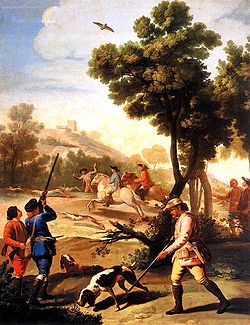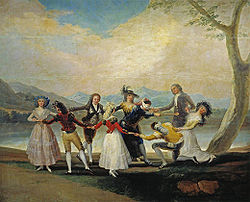
This is a complete list of Francisco Goya's 63 large cartoons for tapestries (Spanish: cartones para tapices) painted on commission for Charles III of Spain and later Charles IV of Spain between 1775 and 1791 to hang in the San Lorenzo de El Escorial and El Pardo palaces. The word "cartoon" is derived from the Italian cartone, which describes a large sheet of paper used in preparation for a later painting or tapestry. [1] Goya's were executed on canvas which was then woven into wool tapestry to a large mural scale. While many of the large finished works are today in the Prado Museum, the original sketches were sold as works in their own right. [2]
Contents
- Groupings
- First series (1775)
- Second series (1776–1778)
- Third series (1778–1779)
- Fourth series (1779–1780)
- Fifth series (1786–1787)
- Sixth series (1787–1788)
- Seventh series (1791–1792)
- Sketches
- See also
- Notes
- Bibliography
In 1774, Goya was asked by the German artist Anton Raphael Mengs, acting on behalf of the Spanish crown, to undertake the series. While designing tapestries was neither prestigious nor well paid, Goya used them, along with his early engravings, to bring himself to wider attention. [3] They afforded his first contact with the Spanish monarchy that was to eventually appoint him court painter. [4] The works are mostly popularist in a rococo style, and were completed early in his career, when he was largely unknown and actively seeking commissions. There is evidence that he later regretted having spent so much effort and time on the pieces, and that his later darker period, which begins roughly with Yard with Lunatics , was in part a reaction against them.
By 1776, aged 29, he had completed five tapestries, by the Real Fábrica de Tapices de Santa Bárbara, the royal tapestry manufactory. His brother-in-law Francisco Bayeu was made director of the tapestry works in 1777, which greatly advanced the ambitious artist's career prospects. [5] However, Goya was beset by illness during the period, and his condition was used against him by the contemporary art scene, which looked jealously upon any artist seen to be rising in stature. Some of the larger cartoons, such as The Wedding, were more than 8 by 10 feet, and had proved a drain on his physical strength. Ever resourceful, Goya turned this misfortune around, claiming that his illness had allowed him the insight to produce works that were more personal and informal. [6] However, he found the format limiting, because being inherently matte, tapestry was unable to capture complex colour shift or texture, and was unsuited to the impasto and glazing techniques he was by then applying to his painted works. [7]
Dating the series has not been difficult as the Royal Tapestry Works maintained a detailed record of the dates, titles, sizes and states in which each of the cartoons arrived. Goya's letters to his friends (in particular his correspondence with the Aragonese industrialist Martín Zapater) contain additional details.








































































